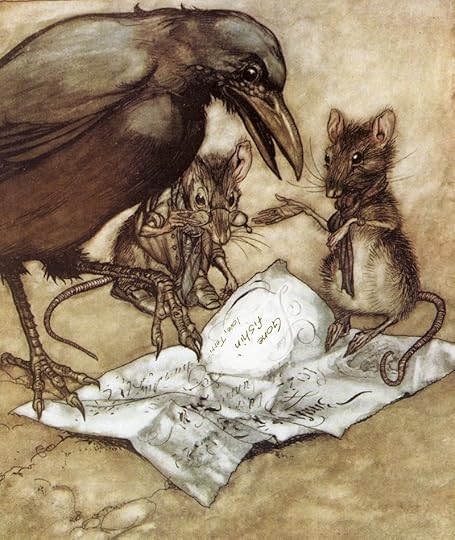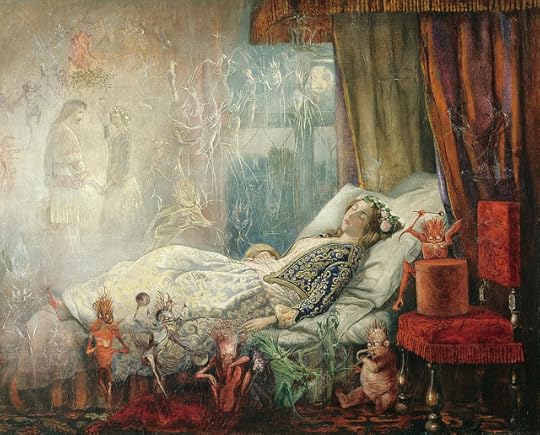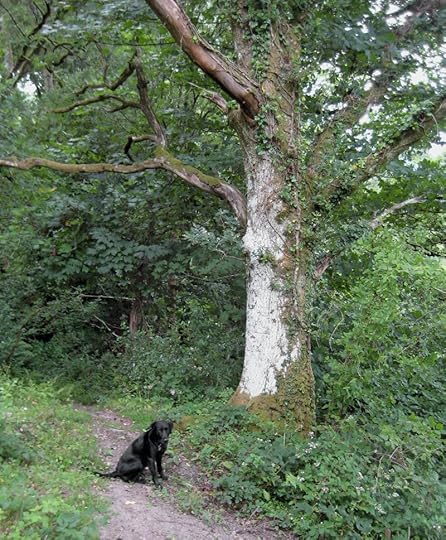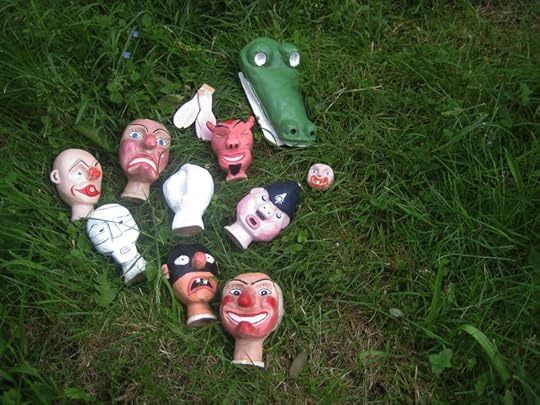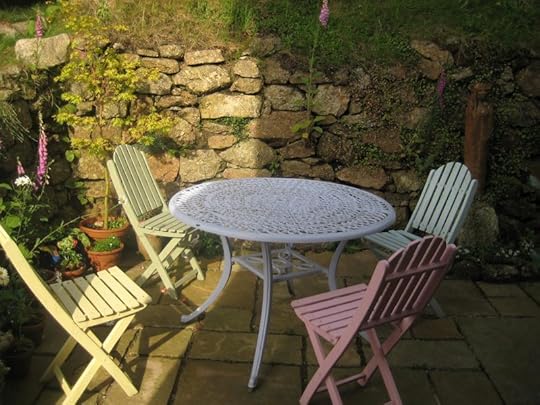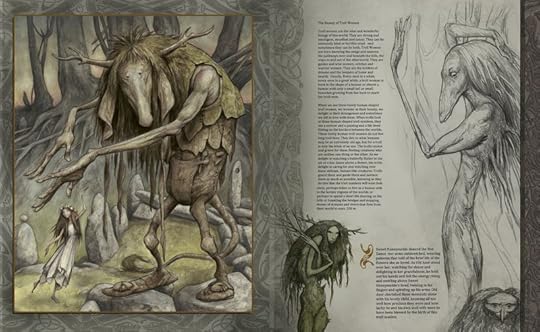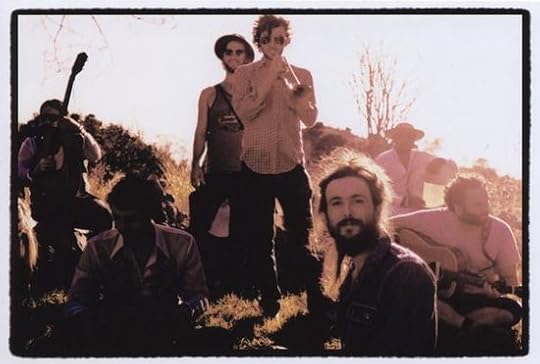Terri Windling's Blog, page 217
July 4, 2012
I'm out of the office until Monday. Have a good weekend...
July 3, 2012
The madness of art
From Christina Cairn's Inspiration or madness...or both?:
"[T]the unfinished piece holds a kind of magic that the finished piece doesn't, a dynamism and vitality because all the possibilities and potentials still exist. And that is the exciting part for me as an artist. Because while that piece stays unfinished, I can hold all those possibilities inside my mind, I can be in all those 'otherworlds' at once. All those contradictions, and impossibilities can co-exist happily. I can move around them, look at them from different points of view, try out different reactions to them. I can thread two together that might seem utterly opposite, and find something beautiful or powerful in that conjunction. And I think this is often the point where that something 'mystical' happens (if we want to put it like that), as if by putting together two disparate ideas we create a pathway that allows something else to come through, something that feels like it doesn't belong to us. A secret whispered in our ears by a muse. Who knows!
"I once told a uni lecturer that I considered myself a 'post-modern humanist', and was told that was impossible because they are utterly contradictory schools of thought. But it makes sense to me. I can believe in faeries on one hand, and not believe in them at the same time. And both are the truth. I can look at an artwork I have created and see every painstaking line, every problem I had to resolve, remember seeing my hand create this and remember all the thought processes that have gone into it, and see it as nothing more than a thing I have made. And at the same time I can be amazed and awed by what seems to be so much more than the fruits of my labour, a thing magical with a power of its own that is nothing to do with me."
"Anytime that is 'betwixt and between' or transitional is the faeries' favorite time," Brian Froud advises. "They inhabit transitional spaces: the bottom of the garden, existing in a space between manmade cultivation and wilderness. Look for them in the space between nurture and nature, they are to be found at all boarders and boundaries, or on the edges of water where it is neither land nor lake, neither path nor pond. They come when we are half-asleep. They come at moments when we least expect them; when our rational mind balances with the fluid irrational."
“What is an artist?" the great Italian filmmaker Federico Fellini once asked. "An artist is a provincial who finds himself somewhere between a physical reality and a metaphysical one. It’s this in-between that I’m calling a province, this frontier country between the tangible world and the intangible one. That is the realm of the artist.”
“We work in the dark - we do what we can - we give what we have," said Henry James. "Our doubt is our passion, and our passion is our task. The rest is the madness of art.”
 Images above: The faery hut in Pigwiggen Wood; cobwebs at dawn (...or are those faeries in flight?); a detail from a painting by Brian Froud; and a summer night at Bumblehill.
Images above: The faery hut in Pigwiggen Wood; cobwebs at dawn (...or are those faeries in flight?); a detail from a painting by Brian Froud; and a summer night at Bumblehill.
July 2, 2012
Courting the muse
"Instead of discussing with myself every morning whether I feel inspired or not, I step into my office every day at nine sharp, open the window and politely ask the muse to enter and kiss me. Sometimes she comes in, more often she does not. But she can never claim that she hasn’t found me waiting in the right place.” - Peter Prange
Image above: Early morning view from the studio.
July 1, 2012
Tunes for a Monday Morning
Today's tunes are...
Above: "Shore to Shore" from the divine Johnny Flynn, who is based in London.
Below: Johnny Flynn joins up with Mumford & Sons, playing fiddle for a little back alley session filmed somewhere in...Paris? Oh, how I would like to be that lucky woman whose yard they end up in! (That's my idea of the Perfect Day, to find Johnny and the Mumfords making music on your doorstep. Throw in Seth Lakeman or Chris Thile and I'd probably die of music-induced happiness on the spot.)
The tunes in the second video are "Banjo Song" and a French-language version of Mumford's "Awake My Soul." The video was filmed by those insanely fabulous folks at La Blogothèque.
June 28, 2012
On Artistic Inspiration
Today's post on artistic inspiration (the beginning of a new Moveable Feast, perhaps, if any other bloggers care to join in...?) was inspired by the conversation with Brian & Wendy Froud over on the JB blog -- which turns, at one point, to the delicate line between Inspiration and Madness. For those of us who work intuitively, as though the Muse is literally whispering into our ears (as I swear sometimes she does), that line can grow rather thin...and I'm always interested in hearing how other writers and artists view this odd aspect of our craft.
In the mythic tradition, both artists and shamans walk perilously close to the realm of madness; indeed, in some cases, their gifts specifically come from journeying into madness, or Faerie, or the Realm of the Gods and then back again. Elizabeth Gilbert, in her acclaimed TED Talk on nurturing creativity, describes how, to the early Romans, an artist's "genius" was a spirit or daemon believed to be attached to that particular artist, and not a personal attribute. The divine spark of inspiration came from the daemon; the artist's job was to be a worthy vessel for that spark. Today, there are still a surprising number of us who view creation much as the Romans did: as a mysterious, magical, alchemical process composed not only of skill and intent but also of ideas and impulses that come through us from some unknown and unknowable place.
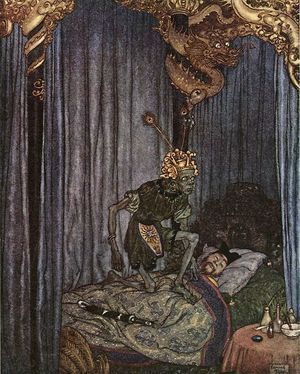 Here, for example, is the Japanese author Haruki Murakami describing his creative process: "A short story I have written long ago would barge into my house in the middle of the night, shake me awake and shout, 'Hey, this is no time for sleeping! You can't forget me, there's still more to write!' Impelled by that voice, I would find myself writing a novel."
Here, for example, is the Japanese author Haruki Murakami describing his creative process: "A short story I have written long ago would barge into my house in the middle of the night, shake me awake and shout, 'Hey, this is no time for sleeping! You can't forget me, there's still more to write!' Impelled by that voice, I would find myself writing a novel."
He's far from the only writer to report that tales and characters sometimes just appear, large as life, demanding to be attended to and rendered into print. On one end of the spectrum are the logical, methodical artists who map their stories and paintings and performances entirely in advance, rarely deviating from the route they've set themselves...and on the other end are the purely intuitive artists who discover the work as they create it -- as though it already exists somewhere, waiting to be found and given earthly form. (The majority of us, I suspect, fall somewhere on the line between the two.)
"I did not deliberately invent Earthsea," writes Ursula Le Guin of her now-classic fantasy series. "I did not think 'Hey wow -- islands are archetypes and archipelagoes are superarchetypes and let's build us an archipelago! I am not an engineer, but an explorer. I discovered Earthsea."
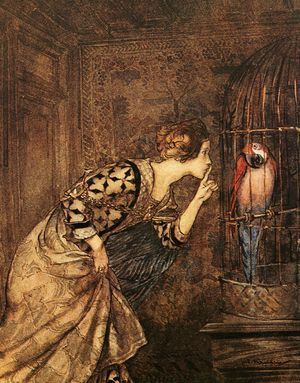 “In a very real way, one writes a story to find out what happens in it," says Samuel R. Delaney. "Before it is written it sits in the mind like a piece of overheard gossip or a bit of intriguing tattle. The story process is like taking up such a piece of gossip, hunting down the people actually involved, questioning them, finding out what really occurred, and visiting pertinent locations. As with gossip, you can't be too surprised if important things turn up that were left out of the first-heard version entirely; or if points initially made much of turn out to have been distorted, or simply not to have happened at all.”
“In a very real way, one writes a story to find out what happens in it," says Samuel R. Delaney. "Before it is written it sits in the mind like a piece of overheard gossip or a bit of intriguing tattle. The story process is like taking up such a piece of gossip, hunting down the people actually involved, questioning them, finding out what really occurred, and visiting pertinent locations. As with gossip, you can't be too surprised if important things turn up that were left out of the first-heard version entirely; or if points initially made much of turn out to have been distorted, or simply not to have happened at all.”
The creative process -- like any mythic act of world creation (which is what it is, even for writers of Realist fiction) -- follows different rules than ordinary living. And that's not always a comfortable thing to experience -- for the artists themselves, or for those close by.
“In the middle of a novel," says Zadie Smith, "a kind of magical thinking takes over. To clarify, the middle of the novel may not happen in the actual geographical centre of the novel. By middle of the novel I mean whatever page you are on when you stop being part of your household and your family and your partner and children and food shopping and dog feeding and reading the post — I mean when there is nothing in the world except your book, and even as your wife tells you she’s sleeping with your brother her face is a gigantic semi-colon, her arms are parentheses and you are wondering whether rummage is a better verb than rifle. The middle of a novel is a state of mind. Strange things happen in it. Time collapses.”
While the world goes on wily-nily without us, we're off chasing visions down the hedgerows of the mind, living in a place where lines and landscapes and imaginary voices become more real than the keyboard under our fingers, the paint in the cup, the vibration of the harp string.
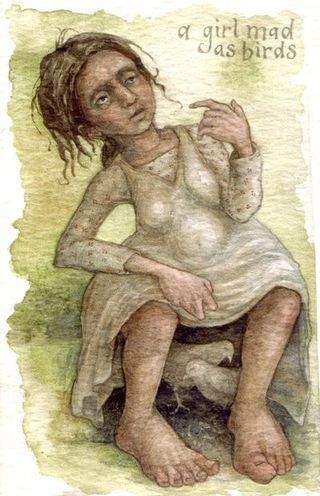 "I discover [my images] in the process of the work," says painter Rima Staines (in an earlier discussion on the JB blog). "I may decide where a figure will go in the frame, but it is rather loose. I am interested in the spark which happens when the image suddenly comes together in front of you and starts to work. It's almost as if, while I'm drawing the lines, what I'm about to draw next reveals itself to me. Maybe I will start to see a face in some loose lines...in the same way that you sometimes see a face or figure in the gnarled bark of a tree. I am not completely in control of the process...it's as though the characters in the image make themselves known to me. It’s like being in an altered state of consciousness. And it can take a real presence of mind to stay in that process. It often feels like walking a tightrope whilst you are creating; it is all too easy to come out of the process and look at your work as critic, or to go the other way and go too far with a particular idea."
"I discover [my images] in the process of the work," says painter Rima Staines (in an earlier discussion on the JB blog). "I may decide where a figure will go in the frame, but it is rather loose. I am interested in the spark which happens when the image suddenly comes together in front of you and starts to work. It's almost as if, while I'm drawing the lines, what I'm about to draw next reveals itself to me. Maybe I will start to see a face in some loose lines...in the same way that you sometimes see a face or figure in the gnarled bark of a tree. I am not completely in control of the process...it's as though the characters in the image make themselves known to me. It’s like being in an altered state of consciousness. And it can take a real presence of mind to stay in that process. It often feels like walking a tightrope whilst you are creating; it is all too easy to come out of the process and look at your work as critic, or to go the other way and go too far with a particular idea."
"Artists often do live in two worlds," Howard comments in Part II of the JB talk with Brian & Wendy, "which is why we can seem a bit mad to other people. One foot is in the real world, where we have to feed ourselves and take on practical jobs to make money, and the other foot is in the creative world, which has a different time scale and demands different things of us: that when you sit down and draw, this is what you are going to draw, and how you are going to draw. Living this way can be both liberating and distressing I find, in equal measure."
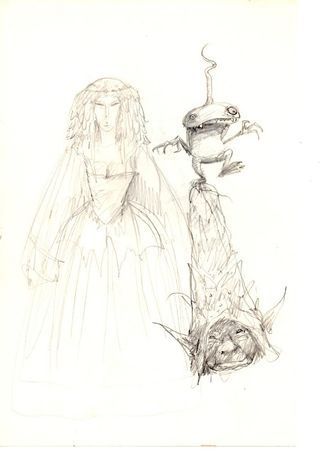 "When I was young, it seemed so much easier," Brian responds. "You just went for it. Youth has an arrogance. Now it’s more of a struggle, but there’s still that inner voice which, when I draw a line, goes: 'No. Rub it out, draw another. 'No.' And then, suddenly, 'Oh, yes!' And then I think: 'Where has that come from? Why is this the right line? While all these others, which to an observer would probably seem to be the same, were wrong?' "
"When I was young, it seemed so much easier," Brian responds. "You just went for it. Youth has an arrogance. Now it’s more of a struggle, but there’s still that inner voice which, when I draw a line, goes: 'No. Rub it out, draw another. 'No.' And then, suddenly, 'Oh, yes!' And then I think: 'Where has that come from? Why is this the right line? While all these others, which to an observer would probably seem to be the same, were wrong?' "
“I think the mystery of art lies in this, that the artists’ relationship is essentially with their work," writes Ursula Le Guin; "not with power, not with profit, not with themselves, not even with their audience.”
That tends to be true for the stories and images that I inevitably find myself most drawn to: art that has arisen from a deeply personal conversation between the artist and the work at hand. It is art that walks perilously close to the Edge, that crosses the river of blood into Faerie, that flies so high it is scorched by the sun, and then returns to tell the tale to us. It is art that needed to be written, or painted, or sung, or woven, or otherwise shaped. It is art gifted by the Mystery to the maker...and then, in turn, gifted to us.
"We're not mad," says Sue Moorcroft, defending the peculiar habits of authors, "we're inhabited.”
Inhabited by the work. Inhabited by the lines, the colors, the characters, the stories. All clamouring to get out into the world.
Images above: "Ferdinand lured by Ariel" by John Everett Millais (1929-1896); illustration from Hans Christian Andersen's "The Nightingale" by Edmund Dulac (1882-1953); illustration from the Child ballad "May Colven" by Arthur Rackham (1867-1939); "A Girl as Mad as Birds" by Rima Staines; a sketchbook page by Brian Froud; and "The stuff that dreams are made of" by John Anster Fitzgerald (1819-1906).
June 27, 2012
Breathing room for the spirit
"I want to write books that unlock the traffic jam in everybody's head. " - John Updike
“Whatever art offered the men and women of previous eras, what it offers our own, it seems to me, is space - a certain breathing room for the spirit. "- John Updike
“What art ought to do is tell stories which are moment-by-moment wonderful, which are true to human experience, and which in no way explain human experience.” ― John Gardner
"If writing is thinking and discovery and selection and order and meaning, it is also awe and reverence and mystery and magic." - Toni Morrison
The beautiful Dartmoor pictures above are by my friend and village neighbor Sarah Howes. From top to bottom: Oncoming Traffic, Dartmoor Foal, The Guardian on the Path, and At the Cottage Window.
June 26, 2012
Ripening like trees
"...Everything is gestation and then bringing forth. To let each impression and each germ of feeling come to completion wholly in itself, in the dark, in the inexpressible, the unconscious, beyond the reach of one's own intelligence, and await with deep humility and patience the birth-hour of a new clarity: that alone is living the artist's life, in understanding and in creating.
"Being an artist means, not reckoning and counting, but ripening like the tree which does not force its sap and stands confidence in the storms of spring without fear that after them may come no summer." - Rainer Maria Rilke (from Letters to a Young Poet)
"Stories are like wine; they need time. So take the time. This isn’t a hot dog eating contest. You’re not being judged on how much you write but rather, how well you do it. Sure, there’s a balance — you have to be generative, have to be swimming forward lest you sink like a stone and find remora fish mating inside your rectum. But generation and creativity should not come at the cost of quality. Give your stories and your career the time and patience it needs." - Chuck Wendig (from his terrific list of 25 Things Writers Should Stop Doing)
A taste of summer
We've been deluged by rain this month in Devon, so when the sun comes out, we grab every single moment of it that we can. Here are some random pictures from a sunny Sunday afternoon here at Bumblehill...
When you live with a theatre director and puppeteer, you never know what's going to end up on the washing line.
In this case, it's a couple of Commedia dell'Arte puppets, and a complete set of costumes for Punch and Judy...
...being given a summer airing. My Pennsylvania Dutch great-aunts used to do that every summer with rugs and eiderdown quilts. Now it's puppets. My life has changed.
The garden has been suffering under wind and rain, but it's an amazing year for the tall pink spires of the foxgloves, which are everywhere -- even the back patio, where they've seeded themselves right into the old stone wall.
Joan Didion has said, “We tell ourselves stories in order to live." I think we also create the lives we need for the stories we want to tell, and the environments we need for our lives and stories both.
"If we marvel at the artist who has written a great book," says Katherine Paterson (in Gates of Excellence: On Reading and Writing Books for Children), "we must marvel more at those people whose lives are works of art and who don't even know it, who wouldn't believe it if they were told. However hard work good writing may be, it is easier than good living."
True words indeed...and so easy to forget as a writer, artist, or performer working under perpetual deadlines, often with little separation (physical or mental) between work life and home life. So on Sundays Howard and I try to turn the computers off, get out of the office, and concentrate on the art of good living. Some weeks we get it right, some weeks we don't...like any form of art-making, really.
Tilly, on the other hand, is a zen master in the art of good living, and in taking each day as it comes. So is Buju, the Costa-Rican-born dog who lives with poet/linguest Taiko Haessler (my good friend Midori Snyder's daughter) and her husband, artist Emilliano Lake-Herrera. I highly recommended Buju's hilarious new Tumblr blog, Adventures in Naplandia.
Now wait a minute, Tilly, that was my seat....
June 25, 2012
A second cuppa with Brian and Wendy Froud...
Part II of the "Around the Table" discussion with Brian and Wendy Froud is now up on the John Barleycorn site. (Part I, if you missed it, is here.) The focus of the talk is on the process of creative collaboration, particularly as regards their forthcoming book on Trolls (above)...but there are also many good insights on the creative process in general, so do go have a look. Then pull up a chair, pour yourself a cup of tea or coffee, and join in the conversation; the Barleycorn boys welcome comments from all.
"When we produce pictures of Trolls, you’re not just looking at pictures of Trolls. I would argue that actually you are looking at a landscape...literally the landscape of Dartmoor...because all of the shapes and forms are based on rocks and roots and trees, and it’s very localised. Then beyond that, not only is it a Troll, and a landscape, it’s also the World. When you are looking at a picture in terms of magic, and magical thinking, everything is encompassed in that one picture; everything!" - Brian Froud
June 24, 2012
Tunes for a Monday Morning
Today tunes....
"Man on Fire" (above), the new video from Edward Sharpe & The Magnetic Zeroes, celebrating the various dancers of New York...
...which reminded me of "Be My Honeypie" (below) by The Weepies, which was also filmed in New York City. I've posted this sweet video before, but it bears repeating!
I hope these two joyous tunes get your work week off to a lovely start.
Terri Windling's Blog
- Terri Windling's profile
- 707 followers


